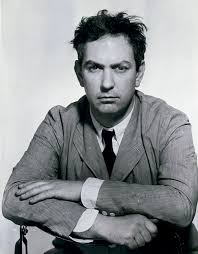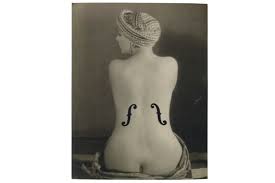Photographer: Man Ray

Analysis of the Artist (Man Ray):
Man Ray was a visionary in both photography and avant-garde art, influencing both the Surrealist and Dadamovements. His works transcend traditional photography, often making the camera and the subject indistinguishable, using processes like solarization (inverting light and dark in prints) and rayographs (images created without a camera). His portraits, such as Le Violon d’Ingres (1924), are playful yet profound, questioning the social standard of beauty and the representation of the body. Man Ray considered photography as amedium that could distort reality in order to investigate the visible and the hidden. In his work, the idea would be that photography is not about the truth but rather calling into question perception, identity, and reality itself. He often played with sexual and provocative themes, making them abstract and intellectual exercises. He saw photography as a means to explore the subconscious, liberated from conventional representation.
1. Intent/Message of the Photographer/Photographs:
Man Ray’s photographs represent a medium to investigate boundaries: those between the conscious and unconscious, identity, and surreal. His work continuously challenges conventional photographic techniques; he does not use the medium to depict reality but to change it. Experimental processes-solarization, rayographs, manipulation of shadows and light-all fall into Man Ray’s aim to push the limits of what a photograph could represent. In his work, one is invited to move beyond the obvious and delve into a deeper, more subconscious realm.
One of the leading messages in his photography has to do with fluidity: identity. He expresses in works like Le Violon d’Ingres (1924) and Noire et Blanche (1926) how the identity can be fragmented, objectified, and remade through the photographic frame. His portraits often involved his muse, Kiki de Montparnasse, and were sensual as well as intellectual, questioning contemporary mores and presenting beauty in the more abstract, often challenging form. Man Ray has used the body as object, transforming it into symbolic, surreal forms, reflecting commentary about objectification, artifice, and perceptions of self. His photographs encourage viewers to question how we define ourselves and how the world sees us, all while celebrating the mysteriousness of human existence.
2. Analyze Their Style:
Technique: The photographic practice of Man Ray is defined by experimental processes. He was known to have utilized solarization-a process whereby the photographic image is re-exposed to light during development partly, creating inverted tones. This produces a surreal, dreamlike effect, adding mystery to his images, emphasizing contrast between light and shadow.
Rayographs: Another unique technique he pioneered was the rayograph, or photograms, in which objects are placed on photo-sensitive paper and exposed to light without the use of a camera. This results in abstract, ethereal images that appear to emerge from the subconscious, much like the principles of Surrealism that influenced him.
Play of Light and Shadow: Man Ray was a master of dramatic lighting. In his portraits, light is often used as something more than simple illumination; it defines form, enhances texture, and at times even distorts reality. His photographs often show the borderline between realism and abstraction, allowing the viewer to perceive the subject from some very new and unusual angle.
Symbolism and Abstraction: The objects are often isolated or veiled; the body parts, too. It is common that the human figure in his work, especially in portraits, is fragmented or distorted. Such abstraction obliges the viewer to engage themselves with the subject at a conceptual level-to think about identity, objectification, and relationship between form and function.
Unconventional compositions were also characteristic of his portraits. For example, Le Violon d’Ingres may present a woman’s back with painted violin f-holes as if the human figure had transformed into some symbolic object. In Noire et Blanche, a tribal mask was placed close to Kiki’s face, something quite out of the ordinary yet strikingly captivating.
The erotic underpinning is often in the work of Man Ray, though these images are not meant to be sexual. Instead, he explores sensuality and ambiguity of the human form, often using eroticism as a way to abstraction.
3. Justify Your Choice:
I have chosen Man Ray because his innovative approach to photography speaks to my desire to create work that goes beyond mere representation. His use of experimental techniques such as solarization and rayographs presents a compelling way of visually distorting reality to evoke the surreal, which is so central to the project I want to create. The fragmentation of the human form in his images will also inspire me to explore themes of identity and objectification.
In my experiments, I will concentrate on the techniques allowing one to manipulate light and shadow for unexpected composition. The use of reflection (as seen in many of Man Ray’s works) will also play a significant role in my experiments to explore how the subject’s identity can be fragmented or redefined through visual tricks. Man Ray’s ability to combine sensuality with abstraction is something that I’d like to incorporate into my work, adding an intellectual layer to my approach. His exploration of the surreal and the unconscious also echoes my own yearning to produce images which are provocative, stirring, and beyond the realm of traditional depiction.
The work of Man Ray opens ways for creative representation of identity complexity. I’m sure his experimental work will inspire me in using techniques in creating mystery-atmospheric shots similar to his portraits.
4. Four of Their Images that Inspire:
1. Le Violon d’Ingres (1924)

- This picture features Kiki de Montparnasse, whose back has been painted with violin f-holes to transform her into a musical instrument. The abstraction of the human form as an artifact is symbolic and surrealistic in speaking toward the notion of objectification and beauty.
Similarity: That inspires me by thinking about how I would alter or abstract certain parts of the body and things found every day in my work.
2. Noire et Blanche (1926):

- Kiki displays against an African mask, creating striking contrast in black and white. Here, she conveys ideas of identity and of cultural borrowing. The mask together with the gaze of the model promotes a surreal dialogue between subject and object.
Similarity: I’ll experiment with contrasting elements, using objects (like mirrors, glass, or fabric) to challenge identity and perception.
3. Rayograph:

- A rayograph is an abstract photogram done without using the camera. This image captures, in an abstract form, the mysteriousness of light and objects and puts them together to make something organic and yet otherworldly.
Similarity: I would like to try out light manipulation and photograms to create an image that subverts reality.
4. Glass Tears (1932):

- This picture focuses on a woman’s face; under her eyes, there are tears made of glass. The use of glass for the representation of tears makes the emotional expression abstract, mixing the emotional and the physical in a haunting way.
Similarity: This encourages me to dig into how I can employ abstract props in order to represent emotion or distort reality.
5. Visual Language to Describe Similarities:
Contrast and Juxtaposition: All of these images use visual contrast—whether between light and shadow, objects and the human form, or different textures—to create tension and provoke thought. That encourages me to research how contrasts can determine the relationship between form and subject.
Abstraction of the Human Form: Through use of symbolism, such as in the violin f-holes, or fragmentation, like the mask in Noire et Blanche, Man Ray’s photography continuously turns the human form into something symbolic or abstract. This will inform how I break down the subject in my images.
Surprise and Dislocation: The use of disorienting compositions and surprise elements by Man Ray provides his work with surrealist and dream-like characteristics. I will experiment with unexpected juxtapositions of ordinary objects to make dream-like or otherworldly combinations.
Conclusion:
Man Ray’s innovative techniques and his ability to explore the surreal, the unconscious, and the complexities of identity through photography make him an ideal inspiration for this project. The way he manipulates light, shadow, and form will influence my experimentation with non-traditional techniques, while his surreally composed images encourage me to rethink how I represent identity and emotion. Through these inspirations, I aspire to create a body of work that challenges the viewer to look beyond the literal and connect with the deeper, more subconscious elements of the subject.
Contact sheets:

Chosen Picture:

This picture shows the kind of magic that Man Ray was all about. The light and shadow is masterful and the contours of the face are sculpted like he does in his portraits. The human form next to the natural element gives the image a surreal quality and the body is abstracted by the play of light which is something he loved to do with the human figure. Experimental techniques and composition make this image more than just a depiction, it invites you to go deeper into the psychological and symbolic meaning of Man Rays photographic way of working.
 This is where, within this picture, I used the Rule of Thirds, where the little red man is offset from the center to the right side of the frame fordynamic balance. Open space around the figure develops a feeling of isolation, and the background gives a sense of disconnection from the setting. The little red man was standing alone on the table; thus, he is disconnected and lonely, even from “society.”
This is where, within this picture, I used the Rule of Thirds, where the little red man is offset from the center to the right side of the frame fordynamic balance. Open space around the figure develops a feeling of isolation, and the background gives a sense of disconnection from the setting. The little red man was standing alone on the table; thus, he is disconnected and lonely, even from “society.” In this shot, I tried to shoot with perspective technique by putting the little red man from a straightforward angle but from slightly lower than the level of his height-so he would look much bigger and significant in the frame. The straight-on view is in opposition to the previous shot when he was lonely in some more or less neutral space. The surrounding emptiness increases the feeling of vastness, further highlighting the red man against the expansive background. His slight turn to the right brings a subtle dynamic, giving him movement and depth.
In this shot, I tried to shoot with perspective technique by putting the little red man from a straightforward angle but from slightly lower than the level of his height-so he would look much bigger and significant in the frame. The straight-on view is in opposition to the previous shot when he was lonely in some more or less neutral space. The surrounding emptiness increases the feeling of vastness, further highlighting the red man against the expansive background. His slight turn to the right brings a subtle dynamic, giving him movement and depth.


 In this shot, I used both perspective and negative space by photographing the little red man from above, looking down, which made him appear even smaller against the great white background. The expanse of empty space surrounding him creates the impression of an empty space that reinforces the separation and loneliness. While this Negative Space focuses the attention on the Red Man, as the centerpiece with the white areas exaggerating the aloneness in addition to his vulnerable entity in the frame.
In this shot, I used both perspective and negative space by photographing the little red man from above, looking down, which made him appear even smaller against the great white background. The expanse of empty space surrounding him creates the impression of an empty space that reinforces the separation and loneliness. While this Negative Space focuses the attention on the Red Man, as the centerpiece with the white areas exaggerating the aloneness in addition to his vulnerable entity in the frame.












Recent Comments